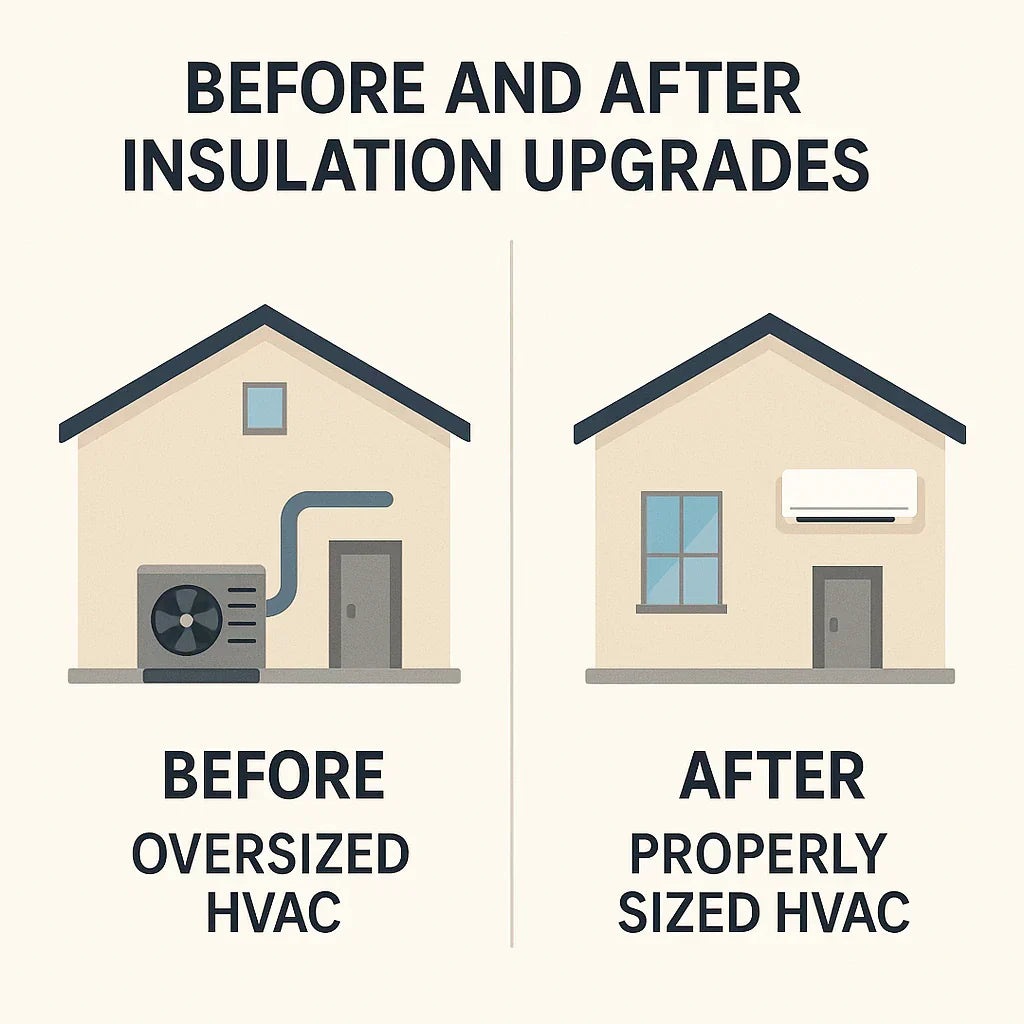When homeowners think about replacing their HVAC system, they often jump straight to brand names, efficiency ratings, or system type. But here’s a crucial step that’s often overlooked: insulation upgrades.
The truth is, your insulation plays a huge role in determining the size of your HVAC system. If you add insulation after installing a new system, your HVAC could end up oversized—wasting energy and money. On the flip side, if you install a system before addressing poor insulation, your unit may be too small to keep up.
In this article, I’ll explain how insulation upgrades change your HVAC sizing needs, why recalculating load is critical, and what steps you can take to get comfort and efficiency right.
For the fundamentals, start with our main guide: How to Size an HVAC System for Your Home.
The Role of Insulation in HVAC Sizing
Insulation acts as a barrier against heat loss in winter and heat gain in summer. Without it, your HVAC system has to work harder, longer, and often with oversized capacity just to keep up.
The DOE’s insulation basics guide explains that insulation directly affects a home’s heating and cooling loads—the primary factors that determine system size.
Simply put:
-
Poor insulation = higher loads = bigger HVAC needed.
-
Strong insulation = reduced loads = smaller, more efficient HVAC.
How Insulation Upgrades Impact Load Calculations
When you improve insulation, you’re changing the math behind HVAC sizing.
Reduced Heating Loads
Better attic, wall, and floor insulation dramatically reduces heat loss in the winter. A home that previously needed a large furnace to keep up may now require a smaller system.
The Energy.gov insulation guide notes that new and retrofitted insulation can cut heating demand so much that many homes qualify for downsized HVAC equipment.
Reduced Cooling Loads
Insulation helps keep hot air out during summer, lowering cooling demand. Pair it with air sealing, and your air conditioner or heat pump no longer has to fight against infiltration from gaps and cracks.
This means your system can be sized smaller, run more efficiently, and still keep your home cool.
Impact on Humidity Control
Insulation and air sealing also stabilize indoor humidity. A tighter building envelope reduces moisture infiltration, meaning your HVAC system doesn’t have to work as hard to dehumidify.
According to ASHRAE comfort standards, maintaining balanced humidity (30–60%) is just as important as temperature. Proper insulation makes this easier for your HVAC system to achieve.
Common Mistakes Contractors Make With Insulation and Sizing
Unfortunately, not all contractors account for insulation when sizing HVAC systems.
-
Sizing before upgrades: Installing a new HVAC system without first upgrading insulation leads to oversized units once insulation is added.
-
Ignoring potential retrofits: Contractors who don’t ask about insulation upgrades may size equipment too large, adding unnecessary cost.
-
Failing to re-run calculations: If insulation levels change, but Manual J isn’t redone, the system size will likely be wrong.
The EPA stresses that insulation, air sealing, and other home performance improvements must always be factored into HVAC system design.
Why Manual J Is Critical After Insulation Upgrades
Manual J is the gold standard for load calculations, developed by the ACCA. This process uses insulation levels, window data, occupancy, and local climate to determine the exact heating and cooling loads of your home.
If you’ve added insulation, your home’s load has changed—sometimes significantly. That means your contractor must re-run Manual J before recommending a new system. Skipping this step risks oversizing, higher costs, and poor performance.
Best Practices for Homeowners
Upgrade Insulation Before Replacing HVAC
If you know your insulation is outdated, upgrade it before shopping for new equipment. This way, your contractor sizes the system based on your home’s improved performance—not its old, leaky state.
Ask for a Fresh Manual J Calculation
Don’t accept rule-of-thumb estimates. Insist on a new Manual J after insulation improvements. It’s the only way to get a right-sized system.
Factor in Air Sealing and Windows
Upgrading insulation alone is good, but sealing leaks and upgrading windows maximize savings. A tighter home envelope = smaller HVAC needs.
Don’t Be Afraid of Downsizing
Some homeowners worry a smaller unit won’t be powerful enough. In reality, right-sized systems run longer, steadier cycles—improving comfort, humidity control, and energy efficiency.
For the next step in this series, check out: How Smart Thermostats and Zoning Affect Sizing Strategy.
Final Thoughts
Insulation upgrades are one of the smartest moves a homeowner can make. Not only do they cut energy bills and improve comfort, but they also directly influence HVAC sizing.
A well-insulated, air-sealed home requires a smaller system, saving you money upfront on equipment and long-term on energy. But to realize those savings, you need a contractor who understands the impact of insulation and recalculates load properly.
Remember:
-
Upgrade insulation before HVAC replacement.
-
Always re-run Manual J after insulation changes.
-
Downsizing isn’t a downgrade—it’s the key to comfort and savings.
Alex Lane
Your Home Comfort Advocate







